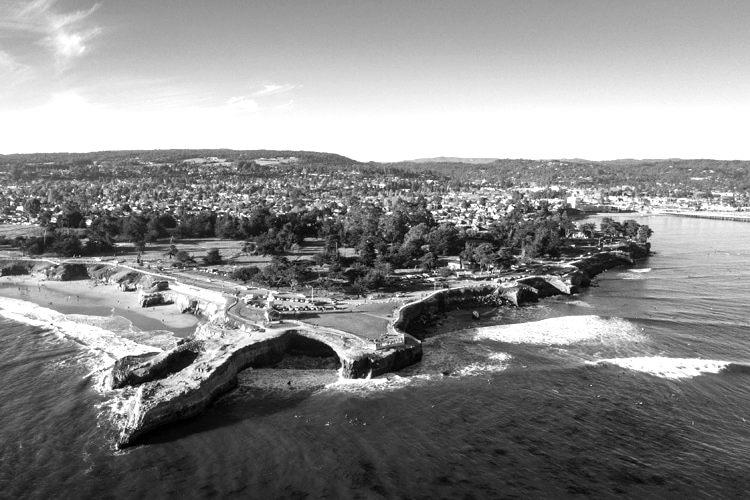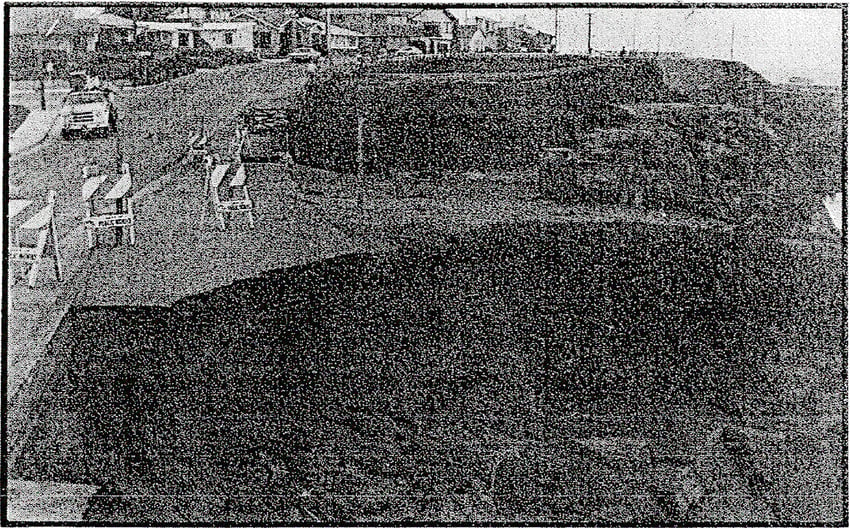Following the victory of saving Lighthouse Point, West Cliff fell into some awkward decades where stopping everything was at the core of the community mindset. Mark Dettle, former Public Works Director, recently told us, “The community became good at stopping things, but it was impossible to create a vision everyone shared during this time.”
Ownership and maintenance responsibility for Lighthouse Point bounced back and forth between California State Parks and the City of Santa Cruz, with nobody wanting to maintain it.
In the early 1980’s Lighthouse Point, under the leadership of Henry Mello, Lighthouse field and “It’s” beach became part of a California State Park known as Lighthouse Field State Beach, managed under the Lighthouse Field State Beach General Plan (1984). Part of the deal was that the City was responsible for maintaining the parks, beaches, roads, and parking lots for the next twenty years.

Image Source: SurferToday
In the first three months of 1983, large waves repeatedly hit West Cliff, many of these at high tides, and caused many washouts and severe damage to the cliffs as well as beach erosion. The City didn’t have the funds to complete repairs properly, and driving along West Cliff Drive was impacted for months. The city completed feasibility studies in 1984/85. Sea walls and riprap revetments were installed in 1985/86.”

Rapid Erosion of unconsolidated terrace deposits took place in January, February, and March 1983 along West Cliff Drive. Image Source: Gary Griggs
Around 1985, California State Parks began discussing closing West Cliff Drive at Pelton and Columbia. A group called the West Cliff Drive Preservation Committee formed in opposition to this closure. They feared that this section of West Cliff would suffer the same fate as the section of West Cliff Drive that used to exist from Swanton to Delaware (it’s no longer freely accessible and permanently part of the Natural Bridges State Park). On a cold and stormy night at the Oblates Church, with a standing room-only crowd, Kim Stoner and others made a strong case that the original land deeds required a permanent road. West Cliff Drive remained open.
Soon after the Loma Prieta earthquake in 1989, the City worked on a project to save the lighthouse and realign West Cliff Drive. There was concern that the lighthouse would fall into the ocean because of the eroding cliffs at Lighthouse Point. The plan was to move the lighthouse back from the cliff by about 100 feet and realign West Cliff Drive inland behind where the restrooms and Steamer Lane Supply exists today. That proposal was met with resistance by the community, and ultimately failed.
During the 1990s, there were several projects proposed for Lighthouse Point and West Cliff. A plan to move the Natural History Museum to Lighthouse Field failed to gain community support. The City, working with the owners of the Dream Inn, proposed a plan to tear down the Dream Inn and rebuild with plans to include a six-story parking lot across West Cliff Drive; that plan also failed.
In a City of Santa Cruz Planning Commission Meeting on September 23, 2004, a motion to approve a final draft of the West Cliff Drive Plan and amendment to the Local Coastal Program failed by a vote of 3/2.
The purpose of the plan was stated to be:
“The purpose of the West Cliff Drive Plan is to establish an implementation program for the various existing land use, design, recreation, circulation, environmental quality, and coastal erosion policies of the Parks and Recreation Element of the General Plan and Local Coastal Program. The General Plan identified West Cliff Drive as an important public promenade designed to provide opportunities for enjoyment and passive recreation in a natural context.”
In 2005, a community group called Lighthouse Field Beach Rescue fought the City and won an appeal to stop dogs from being allowed off-leash at Its (dog) Beach. The community was split over this issue, as many dog owners wanted to continue using Its Beach for their pets’ recreation.
In 2007, after spending a few hundred thousand dollars each year on maintenance, the City surrendered maintenance back to California State Parks. The controversy over Dog Beach and the likelihood of expensive environmental reviews in the aftermath of the court case was a significant factor. California State Parks didn’t have the funding or personnel to manage Lighthouse Field State Beach, and it has since fallen into disrepair.
In 2017, the California Coastal Commission issued an ultimatum to the City of Santa Cruz, and the Sentinel reported:
"Now it seems the commission has had enough. On Thursday, Susan Craig, the commission’s Central Coast district manager, issued a letter to Mark Dettle, Santa Cruz’s Public Works Director, saying that if she doesn’t hear back within a month about next steps for a plan, she’ll notify the commission’s enforcement unit.”
And went on to say:
“Some of the city’s violations are for expired emergency permits — cases in which the city did temporary repairs because property was in danger, but never followed up with a required permanent permit, according to Ryan Moroney, Coastal Commission planner.”
The Coastal Commission demanded a plan and City responded by funding two important projects now known as the Parks 2030 Master Plan and Resilient Coastline Santa Cruz.
There were also attempts to update the 1984 Lighthouse Beach State Park Master Plan, but they faded out in 2020, and the California State Park is still governed under its original 1984 plan.
We collectively couldn’t agree on a plan for West Cliff, and the Coastal Commission called us on it.